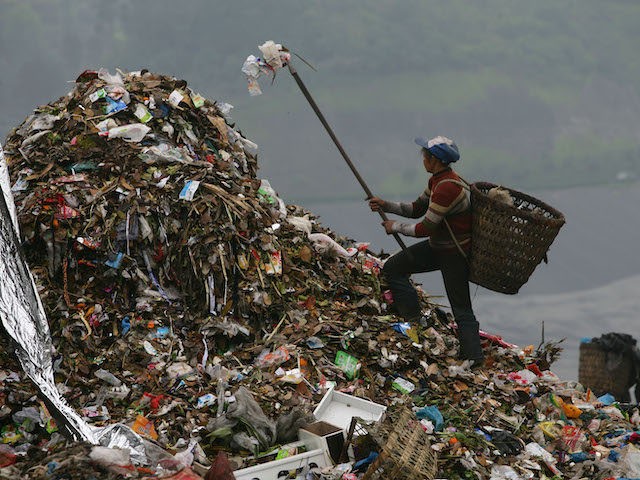The Chinese Communist Party (CCP) is fluent in globalist rhetoric, including the language of the environmentalist movement, but in reality, it remains the gravest threat to the Earth’s atmosphere and ecosystems.
Despite its talk of hitting “carbon neutrality” targets, China built three times as much coal-fired electrical capacity in 2020 as the rest of the world combined. China added a net of almost 30 gigawatts in capacity while the rest of the world reduced coal power by 17.2 gigawatts overall.
China is not slowing down on coal power – it has at least 247 gigawatts of electrical generation under construction, fueling the explosive growth of its heavy industry and providing energy for clients of its Belt and Road infrastructure program.
The Chinese government deflects concerns from foreign environmental groups by merely repeating that it plans to become carbon-neutral by 2060, leaving environmentalists to hope Beijing’s next five-year economic plan includes some actual movement in that direction.
China’s air pollution remains horrific, a problem the CCP deals with by simply lying about it. An analysis published on Wednesday by Harvard and Boston University researchers found “statistically significant differences” between Chinese-run monitoring stations in several large cities and the data collected by U.S. embassy staff.
The researchers concluded that “government-controlled stations systematically underreport pollution levels when local air quality is poor.”
The university researchers wrote:
Local bureaucrats face immense pressure to report the ‘correct’ numbers to their higher-ups, and some resort to colluding with other local officials or misreporting data. Given these institutional incentives to cheat, official air pollution data in China often is treated with a high degree of skepticism, by both outside observers and the general public.
China’s air quality is generally held to have improved over the past few years, but the government’s official air quality targets for 2021 are worse than 2020, ostensibly to allow for industry to rebuild after the coronavirus.
“Prior to the outbreak, the improvement in air quality achieved by sweeping air quality control measures was already being offset by the rapid increase in the production and consumption of steel and coal since 2017,” Time observed in February. China’s greenhouse gas emissions were also rising before the pandemic locked down many industries.
Time explained Chinese air pollution is a problem that reaches far beyond its borders. According to some studies, “air pollution from China contributes to up to 65 percent of the ozone increase in the Western United States.”
Recent studies suggested some 80 percent of the Chinese population is routinely exposed to pollution levels considered dangerous by the U.S. Environmental Protection Agency. Pollution was killing over a million Chinese a year before the coronavirus.
In addition to being the world’s largest emitter of greenhouse gases, China is also the worst emitter of ground and water pollutants like mercury, the largest producer of plastic waste, the worst emitter of marine debris, and the worst perpetrator of illegal and unsustainable fishing practices.
China’s fast-growing cities have chronic problems with waste management and proposed solutions from CCP bureaucrats are often less than friendly to both humans and their environment. Before it became world-famous for other reasons, the city of Wuhan was the scene of massive protests because its poorly-designed trash incinerators were emitting toxic chemicals – some of which damage the human immune system, a detail that became very relevant a year later. City managers decided to address Wuhan’s mounting trash problem by building another incinerator right next to a school and some residential developments.
China’s policy of sending huge paramilitary fishing fleets to occupy disputed waters in the South China Sea inflicted tremendous damage on coral reefs and threatens to deplete vital fishing grounds. Chinese fishing fleets are also beginning to prowl the Western Hemisphere, prompting naval security responses from countries like Ecuador and Peru. In Ghana, poor fishermen complain Chinese trawlers destroyed their livelihoods by wiping out local preserves.
China’s unsanitary “wet markets” are frequently cited as a likely origin for the coronavirus pandemic, and less spectacular disease outbreaks before that. The Chinese government occasionally issues edicts to restrict the wildlife trade, but the $76 billion industry has not been completely shut down, as international health officials have urged.
China’s water control policies are an absolute nightmare for those unlucky enough to live downstream on bodies like the Mekong River, which has been choked off to a trickle in Southeast Asia by Chinese dams. The Chinese have a habit of reducing water levels downstream without warning residents of Laos, Thailand, Myanmar, or Vietnam, and then ignoring their complaints about agricultural losses and ecological damage.
The CCP is ruthlessly exploiting the coronavirus pandemic for political gain by arguing that disciplined authoritarian China is better equipped to tackle big challenges than chaotic capitalist republics like the United States. Environmental activists are prone to indulging China’s current destructive policies, like its coal power plant spree or tremendous production of greenhouse gases, by assuming the tyrannical leadership can snap its fingers and reverse those policies in the near future, transforming the Chinese economy with a scale and speed that would be impossible for free nations to match.
Skeptical observers counter by questioning the willingness of the CCP to jeopardize its industrial expansion and ambitious economic plans to meet environmentalist goals – and even if they are ready to make such sacrifices, reform policies ordered by massive centralized bureaucracies usually do not stick.
China has a long history of announcing grandiose central directives that are soon forgotten after short-term goals are met, and as the false air quality information mentioned above demonstrates, low-level officials have strong incentives to fudge their numbers and conceal difficulties. The world should not require another demonstration of that tendency after the coronavirus nightmare, which spread quickly from Wuhan because local officials didn’t want to admit they faced a problem beyond their control.

COMMENTS
Please let us know if you're having issues with commenting.